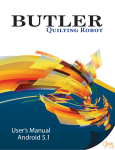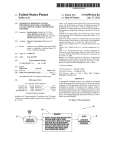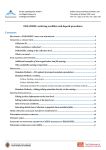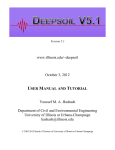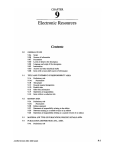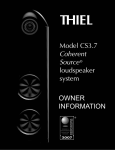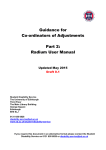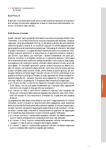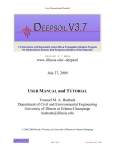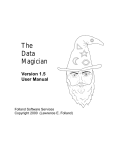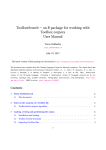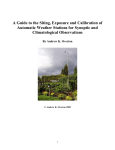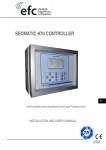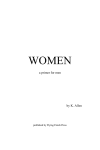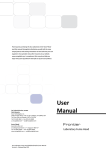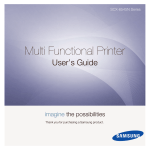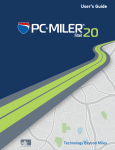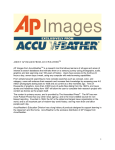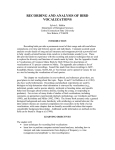Download OLAC NEWSLETTER Volume 5, Number 4 December, 1985
Transcript
OLAC NEWSLETTER
Volume 5, Number 4
December, 1985
FEATURING:
COMPUTERS, CATALOGING AND CHRISTMAS
MEETING AND PROGRAM SCHEDULES FOR MIDWINTER
REPORT FROM THE ALA OLAC SESSION ON CATALOGING MRDF
QUESTIONS AND ANSWERS ON CATALOGING MRDF
UPDATE ON SUBJECT HEADING GUIDELINES
CATALOGING OF AUDIOVISUAL MATERIALS:
A REVIEW
NOTES ON CATALOGING:
A REVIEW
CAPC MEMBER NEEDED
QUESTIONS AND ANSWERS
TABLE OF CONTENTS
FROM THE CHAIR
CAPC VACANCY OCCURS
GUIDELINES TO SUBJECT ACCESS FOR MICROCOMPUTER SOFTWARE NEARLY
READY
FROM THE TREASURER
RENEW YOUR MEMBERSHIP
MEETINGS TO WATCH FOR AT MIDWINTER
COMPUTERS, CATALOGING AND CHRISTMAS
NOTES FOR CATALOGERS: A REVIEW
CATALOGING AUDIOVISUAL MATERIALS: A MANUAL BASED ON AACR2: A REVIEW
CATALOGING MICROCOMPUTER SOFTWARE: A SHARING SESSION
QUESTIONS AND ANSWERS
MEMBERSHIP FORM
FROM THE CHAIR
Katha Massey
Time is rapidly passing, and the Midwinter meetings will be upon us before we know it! OLAC
activities at Midwinter will include:
1. Cataloging Policy Committee meeting chaired by Verna Urbanski on Friday, January 17,
from 8-10 pm.
2. OLAC membership meeting on Saturday, January 18, from 8-10 pm. In addition to the
business meeting, we are planning a question and answer session similar to last year's. Do
come and bring your cataloging questions and concerns.
3. OLAC Executive Board meeting on Sunday, January 19, from 8-10 pm.
All meetings are open and your attendance is welcomed. If you should have an agenda item for
any of these meetings, please send them as soon as possible to Verna (if for CAPC) or to me.
PLEASE NOTE: Although circumstances necessitate a change in place for the OLAC
conference planned for November 1986, the conference is still in the works. OCLC will host the
conference at its headquarters in Dublin, Ohio--so mark your 1986 calendars now! Those of you
who were able to attend the joint OLAC-MOUG conference held at OCLC a couple of years ago,
will remember what a fine job OCLC did in helping make the conference a success. Barbara
Ritchie, Program Chair for the conference, and her committee are continuing to do a super job of
planning a most exciting and practical program for all OLAC members.
OLAC is an active organization please join the action by sharing your concerns and ideas.
CAPC VACANCY OCCURS
The Cataloging Policy Committee of Online Audiovisual Catalogers has accepted the resignation
of one of its members and is now seeking to fill the vacancy. CAPC represents "the concerns of
audiovisual catalogers in matters relating to the formation, interpretation and implementation of
national and international cataloging standards and related matters." It is a standing committee of
OLAC consisting of seven voting members and two ex-officio members. Members serve two
year terms. Qualified candidates will either currently catalog av materials or have equivalent
experience. Candidates should have three years of qualifying experience before appointment to
CAPC. Candidates must be willing to commit time and funds as necessary to meet at midwinter
and annual ALA conferences for the purpose of conducting CAPC business. Additionally,
candidates should interact regularly with online cataloging systems or have a demonstrable
knowledge of such systems.
Appointments to the committee are made by the Chair of OLAC following consultation and
review of the applications by the Executive Board. If you are a member of OLAC and are
interested in serving on CAPC, submit a recent resume and a cover letter which addresses the
qualifications indicated above. Send letters to: Katha Massey, OLAC Chair, Catalog
Department, University of Georgia Libraries, Athens, GA 30602
GUIDELINES TO SUBJECT ACCESS FOR
MICROCOMPUTER SOFTWARE NEARLY READY
The ALA RTSD/CCS/SAC ad hoc Subcommittee on Subject Access to Microcomputer Software
has completed its work!! The guidelines on subject access to microcomputer software should be
available at ALA Midwinter in Chicago or shortly thereafter. The guidelines contain advice on
subject analysis and classification for microcomputer software. A special feature of the
document is an appendix of useful subject headings for software taken from LCSH and Hennepin
County Library Authority List. For more information contact: Joan Mitchell, AT&T Bell
Laboratories, Crawfords Corner Rd., Room 2G-110, Holmdel, NJ 07733
FROM THE TREASURER
Catherine Leonardi
Reporting period:
July 16, 1985 through October 14, 1985
Account balance July 16, 1985
$4,462.74
INCOME
New memberships
Renewal memberships
Interest on regular account
Interest on CD
Back issues
TOTAL INCOME
TOTAL
234.00
133.00
94.51
152.42
60.00
-----------$ 673.93
$5,136.67
EXPENSES
Newsletter (v.5, no.3
includes $50. editor stipend)
ALA Chicago summer '85
AV equipment
Room fees
Postage -- treasurer
Logo contest award
TOTAL EXPENSES
808.97
90.00
160.00
25.20
25.00
-----------$1,109.17
Account Balance October 14, 1985
CD at 7.7% matures 3/5/86
CD at 10% matures 3/19/86
$4,027.50
$2,000.00
$2,000.00
TOTAL OLAC ASSETS
$8,027.50
CURRENT MEMBERSHIP
559
<><><><><><><><><><><><><><><><><><><><><><><><><><>
RENEW YOUR MEMBERSHIP
OR FACE DIRE CONSEQUENCES
<><><><><><><><><><><><><><><><><><><><><><><><><><>
As we all know "dire" is a relative term. In this case it is related to losing your membership,
losing valuable information, losing incalculable amounts of insider talk and in general falling out
of touch with the throbbing pulse of av librarianship.
If you are ready to risk these dangers (perhaps even to initiate the decline and fall of your library
by your neglect) DO NOT RESPOND TO THIS REMINDER. If, on the other hand, you want to
have all the advantages which continued membership in OLAC provides (not the least of which
is continued receipt of this newsletter) then RENEW NOW. We promise you will catalog media
happier ever after or receive a firm apology from the management (provided you can find them).
TEMPUS FUGIT
RENEW NOW!!! NO POSTHOLIDAY
SPECIALS WILL BE OFFERED
Check your Mailing label---If it says "Expires 12-85" -- RENEW
MEETINGS TO WATCH FOR AT MIDWINTER
Friday, January 17th
8:00 pm - 10:00 pm
Online Audiovisual Catalogers, Inc.,
Cataloging Policy Committee (CAPC)
Chicago Hilton Conference Room 4B
Saturday, January 18th
9:30 am - 12:30 pm
RTSD/LITA/RASD Representation in
Machine-readable Form of Bibliographic
Information Committee (MARBI)
Chicago Hilton Conference Room 4K
4:30 pm - 5:30 pm
PLA Audiovisual Committee
Americana Congress Gold Room Table 12
8:00 pm - 10:00 pm
OLAC business meeting
Chicago Hilton Boulevard Room C
Sunday, January 19th
2:00 pm - 4:00 pm
MARBI
Chicago Hilton Williford Room A
8:00 pm - 10:00 pm
OLAC Executive Board Meeting
Chicago Hilton Conference Room 5C
8:00 pm - 10:00 pm
ACRL Rare Books and Manuscripts Section
MARC Cataloging for Special Collections
Information Exchange Committee
Palmer House Private Dining Room 16
Monday, January 20th
9:30 am - 11:00 am
PLA Audiovisual Committee
Palmer House Burnham Room 3
2:00 pm - 4:00 pm
ACRL Audiovisual Committee
Palmer House Montrose Room 2
2:00 pm - 5:30 pm
MARBI
Americana Congress Plaza Room
Tuesday, January 21st
8:00 am - 11:00 am
MARBI
Chicago Hilton Conference Room 4K
2:00 pm - 5:30 pm
RTSD Audiovisual Committee
Palmer House Parlor G
COMPUTERS CATALOGING AND CHRISTMAS
Catherine Leonardi
It is time to make a Christmas wish list and I'd like to start with my own personal computer
complete with keyboard, monitor and two disk drives. In fact, I'd like a computer for each
cataloger, both professional and para-professonal and for every one who supervises cataloging in
my library. And, I'd like all of these to be linked together so that we could review and revise each
other's cataloging. I'd also like several printers to be available on this system.
The next order of business would be for these computers to interface our local online catalog and
OCLC. Each computer would have access to a system I'd call CACP (computer-assisted
cataloging program). CACP would display a group of fields common to whatever type of
material the cataloger was working on. Far example, when cataloging sound recordings the
cataloger would use a workform that would contain fields like 007, 028, 048 and 049. Then with
a push of a button the cataloger would transfer the needed field to her cataloging record.
CACP would allow the cataloger to easily add fields to the workforms as needed. For example,
when doing a bound-with, the call number and "with" note would he added to the CACP
workform. Then the cataloger would push a button and have this information transferred to the
catalog record. Then the cataloger could finish editing the cataloging. When finished with the
CACP basic workform, the cataloger would remove the specific fields leaving the workform
ready for the next use.
One of the nicest features of my CACP system would be a split screen which would allow the
cataloger to view part of an OCLC catalog record and to manipulate a CACP workform at the
same time. If the cataloger were editing OCLC copy for a VHS videocassette, she could call up
the CACP VHS workform. The split screen would show the OCLC copy fixed fields in the upper
half and the CACP VHS fixed fields in the lower half. A button would allow the cursor to move
freely. At each field, the cataloger could leave the information as given on the OCLC copy or
change it. One key stroke would move the field to the CACP VMS workform.
When the fixed fields were completed the cataloger could scroll (using two separate control
keys) the two halves of the screen to view the variable fields on the OCLC record and the
workform simultaneously. By having two separate advance keys, the workforms could be
manipulated independently. This would allow the cataloger to copy workform fields easily into
the record. When editing was complete the two halves of the screen could be scrolled slowly to
check for additions and corrections. When finished, the record could either be stored for review
or produced.
This is what I'd like Santa to put in my stocking this year. If anyone can think of good additions
to my computer wish list, I'd like to hear from you---preferably before Christmas Eve.
NOTES FOR CATALOGERS
A REVIEW
Notes for Catalogers: a Sourcebook for Use With AACR2 is said by its authors, Florence
Salinger and Eileen Zagon, to have evolved from Monograph Cataloging Notes. The key to the
evolutionary process is, in this case, a broadening of focus to include not just monographs, but
all materials covered by chapters 1-12 of AACR2. The book is intended to help catalogers decide
on the appropriateness of a note and to suggest phrasing and punctuation. The authors followed
the practices of LC in so far as those could be determined from looking at LC cataloging and
following the interpretations provided by Cataloging Service Bulletin.
The chapters of this sourcebook follow the organizational pattern of AACR2. Notes appropriate
to each rule within a chapter are to be found clustered under that rule. All materials are included
except early printer monographs. There are even samples for chapter 1 notes. These "represent
valid notes on materials for which there is not rule accommodation within their respective
chapters in AACR2" (Preface, p. vi). This is a handy feature. It wasn't until seeing sample notes
for three dimensional materials under 1.7B2, that the reviewer registered the fact that no
provision has been made for these notes in chapter 10.782. In addition, that intentionally
neglected media, kits, receives the benefit of 8 samples in this section. A modest sampling it will
be admitted, but it is a start!
Notes under each rule don't cluster as completely as they might. For example, notes for added
title page titles appear as citations 203-204, and 214-215 in chapter 2 and could just as well have
all been together. This is not a major flaw once the user understands that it happens and that it is
best to scan the entire category to get the fullest benefit. The alternative is to use the subject
index and follow-up on each citation mentioned there for appropriate chapters. Users need to be
aware that the subject index is... "selective: examples of a certain subject may recur throughout
the chapters, but only a representative selection of examples is referenced in the index" (Preface,
p. vii).
Notes provided under one rule are often very similar, but the authors appear to add at least one
distinct feature to each note so that exact duplications are not common. The reviewer found the
examples for numbers notes to be consistently helpful (_.B19). She also found the notes for
accompanying material for text and cartographic materials to be helpful, but to be disappointing
in their quantity and quality for other chapters. For instance, only three examples are given for
chapter 5 material. Chapter 7 is nearly as skimpy.
Publication of Notes for Catalogers marks yet another step forward in the struggle to legitimize
the full cataloging of audiovisual materials. Just as AACR2 makes cataloging of media a
standard practice for "normal" libraries (not just the lunatic fringe!!!), so Notes for Catalogers
recognizes the valid needs of both media catalogers and media users.
This reviewer recommends Notes for Catalogers with confidence. Its cost is modest for the
amount of information it contains. Congratulations are due the authors on a job well done.
Catalogers will always wish for just one more sample note to fit exactly their situation, but that
keeps life interesting!!
--- Reviewed by Verna Urbanski
Available: Knowledge Industry Publications, inc., 701 Westchester Ave., White Plains, NY
10604.
CATALOGING OF AUDIOVISUAL MATERIALS:
A MANUAL BASED ON AACR2
by Nancy B. Olson---A REVIEW
Nancy Olson's second edition of Cataloging of Audiovisual Materials comes to the av cataloger
with accessible information in an attractive and easy to use format. CoAM2 continues the Olson
tradition of writing for both the practicing cataloger and the student of av cataloging.
The manual is based on AACR2 and the published rule interpretations of the Library of
Congress. CoAM2 fully revises the text and examples of the original edition and adds further
examples. It includes a chapter on cataloging microcomputer software using the guidelines
issued by ALA in July, 1984. Subject headings from Sears and LCSH have been added to all the
cataloging examples as have Dewey and LC classification numbers.
The manual covers descriptive cataloging, but also includes information which would be helpful
in administering an AV collection. Olson presents a logical consideration of the many questions
which need answered to run an efficient AV collection. Chapter 2 ("Cataloging Audiovisual
Materials") is especially helpful in its description of the handling of the title information on AV.
New to this edition are the sections discussing the assignment of subject headings, the rationale
for classifying AV and the treatment of "In" analytics. All are valuable additions.
Individual chapters provide guidance by media group. New media are included, for example,
there is discussion of, and a cataloging example provided for, a compact disc. One of the most
useful sections is sure to be the chapter on cataloging microcomputer software with its discussion
of the file description area and the practical "notes" samples. The chapter on cataloging AV
serials is particularly useful at this time when rumblings are being heard regarding the need for a
MARC format for AV serials. As in CoAM1, the discussion of cataloging kits serves to
crystallize several options for this vague material that everyone knows but few can define
clearly.
Coding and tagging for the cataloging examples is available in a separately published monograph
rather than in the back of the main text as in the first edition. This is a sensible innovation which
keeps the text of the basic manual a useable size while providing a separate handy guide for
OCLC users. The coding and tagging has not been officially sanctioned by OCLC, but represents
the expertise acquired by Olson after nine years cataloging AV on OCLC. The coding
supplement comes with a wall chart of the 007 field containing all the variables for the formats
currently using an 007. Olson plans to publish coding and tagging supplements for UTLAS,
WLN and RLIN users as well. We are happy to see Olson continuing the practice of furnishing
coding and tagging for her cataloged samples. Her's is the only manual which does this and the
value of the effort needs to be recognized.
Cataloging of Audiovisual Materials continues with this second edition to prove its value to the
AV cataloging community. Its information is accessible, the writing style relaxed and clean.
Olson manages to demystify AV cataloging while revealing the layers of decision-making which
goes on almost automatically in the mind of an accomplished cataloger. The manual and its
supplement are useful at all skill levels and across all types of libraries regardless of the degree
of automation. It is a welcome addition to the manuals available to a growing community of AV
catalogers.
--- Reviewed by Verna Urbanski
AVAILABLE: Minnesota Scholarly Press, PO Box 224, Mankato, MN 56001 (507) 387-4964.
/// Manual ISBN 0-933474-38-5 $34.50 /// Coding supplement ISBN 0-933474-39-3 $15.00.
CATALOGING MICROCOMPUTER SOFTWARE:
A SHARING SESSION
Online Audiovisual Catalogers sponsored a sharing session on the cataloging of microcomputer
software during this summer's American Library Association annual conference. The more than
100 attendees ran the gamut from those who were acknowledged experts to those who needed to
know a little just to get started. The session was held July 9th from 9:00 to 11:00 am. The format
included brief presentations by a panel of specialists and a group discussion period followed by a
question and answer session with the panel fielding questions from the groups. The session was
ably moderated by Sheila Intner, immediate past chair of OLAC and visiting assistant professor
at UCLA. Panelists included: Ann Fox (LC), Judy McDermott (LC), Glenn Patton (OCLC) and
Pat Luthin (Georgetown University). Facilitators during the group discussion sessions included:
Bonnie Fletcher (U of Wisconsin-Whitewater), Peggy Kellogg (SUNY Geneseo), Susan Koch
(Arlington Heights Memorial Library (IL)), Robert Mead-Donaldson (Florida International
University), Jean Armour Polly (Liverpool Public Library (NY)) and Ann Weber (U of North
Carolina at Charlotte).
Judy McDermott briefly described the work that has been going on at LC to prepare for
the pilot project CIP for microcomputer software. LC plans to begin cataloging MRDF by
next spring. There are still several questions to resolve including biggies like where to put
the CIP information on the software. Cooperating producers are in the process of being
contacted.
Ann Fox followed up Judy's outline by discussing the CIP software data sheet that is
being drafted and by showing some examples of what the CIP entry may look like.
The data sheet filled in by producers of software will be used by LC as the basis for CIP
cataloging so it must be designed with care to elicit useful and precise information. It
must be a document that can be understood by those filling it out and also provide
pertinent information without burdening the producers unduly. The data sheet has already
gone through several drafts. LC feels that the essentials needed to create a useful data
sheet will include: a carefully structured set of instructions for the publishers, a facsimile
of the software screen displays, information on the target audience, what category the
software falls into (i.e., spread sheet, word processing, database management, etc.), file
description (type and number of files), what systems the software runs on, what formats
and versions are available. The data sheet will ask the producers to describe the software
in terms of shippable units.
The degree of fullness provided by the CIP has not yet been decided upon but three basic
options are a full record, a modified record and a basic record. The basic record would be
similar to the current CIP used for books. The drawback to using this style is that the file
description would not be provided. This is an area that catalogers consistently report
having trouble constructing for MRDF and it therefore is a highly desirable set of
information to provide. The full record, while the most useful to the users of CIP, might
require more time to construct than is practical in a CIP program.
Glenn Patton outlined OCLC's early and continuing involvement with MRDF cataloging.
Nancy Olson instigated the creation of Guidelines for Using AACR2 Chapter 9 for
Cataloging Microcomputer Software when she was with OCLC as visiting scholar during
1982/83. It was due to her interest and expertise that a group was assembled which
eventually produced the CC:DA approved and ALA-published guidelines. OCLC
implemented the MRDF format in October, 1984. 4,000 titles have been entered so far on
OCLC. Though the rate of input has slowed in the last quarter, the number of holdings
attached to the records already input continues to grow steadily.
Glenn has been the project supervisor for the implementation of the MRDF format at
OCLC. As such he has been involved not only in bringing up the format, but in designing
training materials and doing workshops. There is a greater emphasis on the problems
associated with cataloging MRDF, not just implementation of the format. Most interest at
the workshops is in the cataloging of microcomputer software rather than mainframe
software. One of the most striking observations Glenn made during these workshops is
the number of catalogers who have no access to the computers on which the software
runs. This means catalogers are virtually dependent on the information provided by the
external surfaces of the software, the packaging and accompanying material, for
cataloging information. OCLC is currently working on clarifying the language in their
format to make it more helpful to catalogers.
Pat Cuthin is a member of the subcommittee of the Subject Analysis Committee that has
been working to develop guidelines for the consistent subject analysis of microcomputer
software. The subcommittee's recommendations will include five major points:
1. Catalogers should make full use of Guidelines for Using AACR2 Chapter 9 for
Cataloging Microcomputer Software;
2. Catalogers should use established subject lists;
3. Classification of microcomputer software should be mainstreamed with other
materials;
4. The free floating subdivision "software" should be adopted to differentiate
software from other media and from text;
5. Catalogers should avoid using the make, model, operating system for subject
headings. If this access is needed, catalogers should use the 753 field recently
approved for addition to the MRDF format.
The subcommittee hopes to move the set of recommendations through the appropriate
approval channels during this conference and to see publication of it by Midwinter
conference.
Moderator, Sheila Intner announced that a Dewey classification phoenix is available for
computer software. Forest Press is the publisher and it is titled: Dewey Decimal
Classification 004-006, Data Processing in Computer Science and Changes in Related
Disciplines.
*******************************************************************
QUESTIONS & ANSWERS FROM THE SHARING SESSION
*******************************************************************
QUESTION: If we find cataloging online but ours runs on a different machine, do we input a
new record or can we modify the online record?
ANSWER: You should input a new record unless if, as is, it runs on more than one machine
including the one you will be using it on. You may want to adjust the wording of the system
requirements note to give prominence to the machine available in your library.
--- Glenn Patton
QUESTION: How about version changes, for instance, from version 1 to version 1.3?
ANSWER: Yes, version changes require a separate record. Remember you can use the "new"
function to clone the basic record for modification to save on keying in information.
--- Glenn Patton
QUESTION: What do we do with software that accompanies a book? Sometimes LC has
cataloged the title, but doesn't mention the software.
ANSWER: LC is still exploring this question. It must be determined whether the software is
accompanying the book or the book is accompanying the software.
--- Ann Fox
LC is trying to get the publishers to be more specific about this situation, so LC will have an idea
of their intent.
--- Judy McDermott
LC may not have received the software and may not be aware that it exists.
--- Dick Thaxter
The user can add the information to the online record. This is one of those situations where the
cataloger must use judgment.
--- Sheila Intner
QUESTION: If the statement of responsibility is not prominent, should we ferret it out?
ANSWER: Stay within the general guidelines provided for this area in AACR2 and the
guidelines for chapter 9. Examine the credits and use your judgment.
--- Ann Fox
Don't dig to find it. Area of responsibility is always supposed to be for prominently named
parties.
--- Glenn Patton
QUESTION: Can the extent in the 300 field be changed to say 1 disk instead of asking for a file
description?
ANSWER: There are some proposals to this effect being considered currently by a CC:DA task
force which is reviewing the Guidelines for Using AACR2 Chapter 9 for Cataloging
Microcomputer Software published last year by ALA. Even under these current guidelines you
can OPTIONALLY choose to describe the carrier rather than the extent of the file, or, you can
also say "ca. 1 file".
--- Sheila Intner
QUESTION: What is a data file? What is a program file? How can we calculate or find that
information with the material we have in our hands?
ANSWER: The best bet if you know nothing about this, is to read the definitions in the glossary
of the guidelines and then look at the way the information is presented in the item. The object is
to do this as quickly and expeditiously as possible. If you can look at a menu, look only at the
main menu and surmise the files from that. Do not try to count the files in submenus.
--- Ann Fox
QUESTION: How do you select an appropriate record on OCLC when the online record has a
copyright date which differs from the one that can be found on the item in hand and the cataloger
doesn't have access to a machine to view the screen?
ANSWER: Match what you've got, if you don't have the internal screen, use the external data
available and select an OCLC record based on that.
--- Sheila Intner
Yes, you must use your own best judgment as to whether this is the same title or not.
--- Glenn Patton
QUESTION: We notice that the examples of different levels of cataloging handed out earlier
shows the audience note before the system requirement note. This doesn't seem very logical to
us. The system requirements seem more important.
ANSWER:This is the order of notes indicated in the guidelines. (9.7B14)
--- Ann Fox
QUESTION: How should we use the 753 field? Should we do one for each machine the
software will run on, or, just for the machines at hand?
ANSWER: Make 753 added entries just far the machines you have in hand.
--- Judy McDermott
Don 't go beyond what is described on the item. Catalogers may want to limit to the machine(s)
at hand. People who are wanting this software will have some sophistication about what
machines will run what software. We may tend to spoonfeed our users a bit on things like this.
--- Glenn Patton
QUESTION: When do you use a personal author as main entry?
ANSWER:Use appropriate AACR2 rules if authorship can be attributed.
--- Ann Fox
No special rules of entry exist by material in AACR2 as they did in earlier cataloging rules.
--- Glenn Patton
QUESTION:What do we do about entering ISBN numbers for microcomputer software?
ANSWER: A committee of NISO is currently looking into this question. The proposed format
coming out of that group has been rejected and the usability of ISBN is being examined.
--- Ann Fox
Bowker began assigning ISBNs to materials handles. This is a very troubling turn of events
because it has a publisher establishing a national standard by fiat.
--- Sheila Intner
[NISO has had a change of heart---ISBN's won out.--- ed.]
QUESTION: The subject access provided by LCSH is not adequate for microcomputer
software. What can be done?
ANSWER: The microcomputer subject access report has a very helpful bibliography. When it is
available (hopefully by Midwinter) users wanting extra help may find this a useful to supplement
LCSH. The subject list of Hennepin County public library system includes terms to use for
software. It might be helpful to use these.
--- Pat Luthin
QUESTION: The language coding in the MRDF format causes confusion. Why do some code it
"eng" and other "n/a"?
ANSWER: OCLC's interpretation of the MARC format is, in this case, very strict. You do not
have a language code unless it is a text file. A language code from the code list is appropriate
only in cases where you have a textual data file. In all other cases you do not have a codeable
language. It is not that a language (COBOL, FORTRAN, etc.) isn't being used. There simply is
no code in the code list to use with these. So the appropriate language code is n/a or
blank,blank,blank. Some people believe they need to say something about what the language of
interaction is. That is, what language you see in the screen displays. That is a possibility and
perhaps we need an addition to the MARC format to allow for that.
--- Glenn Patton
QUESTION:Some of us do not know what "a textual data file" is.
ANSWER: Moby Dick translated into machine readable form is a textual data file.
--- Glenn Patton
QUESTION: Is OCLC going to index the 753?
ANSWER: There are no immediate plans to index the 753 field. The present system is being
redesigned and will carry with it various kinds of keyword searching which may be more useful
in this case than a derived search key.
--- Glenn Patton
*******************************************************************
MORE QUESTIONS & ANSWERS FROM THE SHARING SESSION
The next several pages contain answers provided by Glenn Patton (OCLC), Nancy Olson
(Mankato State University) and Sheila Intner (UCLA Graduate School of Library and
Information Science) to a list of questions which could not be answered during the program in
Chicago. The response of each expert is provided unless the answers duplicate, then the most
inclusive answer was selected. When conflicting opinions arise each has been provided. Later
clarification may be necessary. These differences demonstrates that even among the experts
opinions vary. A reassuring thought to many of us and a further verification of the importance of
"catalogers judgment." Many thanks are due to these three OLAC members for taking the time to
answer these questions for us. They are outstanding OLAC members who continue to give
unstintingly of their time and expertise on an ongoing basis.
*******************************************************************
1. Are "created by" and "produced by" statements considered statements of responsibility?
PATTON: Certainly
OLSON: I consider "created by" and "produced by" to be statements of
responsibility.
INTNER: Yes, but -- "created by" without any other competing statements like
"programmed by " or "designed by " or "written by" could be taken to be a
statement of responsibility. If there are other such statements, then I would put
them in a note, including the "created by". "Produced by" is not the same. I would
interpret "produced by" as a responsibility for technical production, not
intellectual creation.
2. What should be done with copyright: statements when copyright is held by a person?
PATTON: Such a copyright statement cannot be construed to mean anything
more than ownership of the copyright. Thus, a personal name presented with a
copyright statement could not be recorded as a statement of responsibility unless
there was other evidence of "responsibility." I would suggest recording it in a
note. An added entry could be made for the name based on the note (see OCLC
#11214492).
OLSON: When a copyright statement contains the name of a person, and that
person is not named anywhere else, I would make a note. EX: Copyright by
______.
If the package being cataloged consisted of only the item containing the above
mentioned copyright statement, I would also use the person as main entry,
reasoning that the person, in claiming the copyright, claimed authorship or rights
as creator of the item in question.
If, however, there were one or more other items in the package (teacher's guide,
user's manual, workbook, chart, worksheets, etc.), I would look to see if any of
those had a title page or title page equivalent, and if they named the same person,
different person(s), or no one as author. I would then consider the importance of
the item with the personal copyright in comparison to the rest of the package .
How much was the person responsible for? How much was someone else
responsible for? How much was unattributed? Then I would make my main entry
decision.
I would make the copyright note anytime a person was named there who was not
named anywhere else, to justify at least an added entry for the person. If the
person were named elsewhere my note would refer to that authorship: EX:
Manual by ______.
INTNER: For dates, do exactly the same thing as when that occurs in books. If it
is the only date, use it. If there is another "publication" date or "release" date, use
that first, followed by the copyright date if it differs.
3. How much of the accompanying documentation should be used in the bibliographic
description? What gets bracketed? [comment from the facilitator--"This person wasn't
understanding the chief source of information, apparently."]
PATTON: Guidelines for Using AACR2 Chapter 9 for Cataloging
Microcomputer Software (Hereafter, Guidelines) (p.2-3) does not limit you to any
portion of the accompanying documentation. You need to bracket only if you take
information from a source other than the chief source of information.
OLSON: All the items should be included in area 5, even if as "+ various
materials." The question may refer to the cases when the accompanying text is a
substantial one with title, authors, etc,, which is designed to be used with the
microcomputer program, I do as follows:
+ text.
Then make a note:
Text:
Title / statement of responsibility.
Edition. Publication information. Area 5
information (Series).
and leave out any of the above information that repeats the 2XX-4XX information
already given. Logo packages often include a copy of the text on Logo which is
related, but not a user's guide. This could be pulled out and cataloged separately.
Use as much as is necessary for your users. Don 't bracket unless the information
comes from a reference source outside the work in hand (and all its little parts).
4. Some software is "secured" so that any bibliographic information which may be stated
internally cannot be easily accessed. Upon what should the bibliographic information be
based?
PATTON: If you cannot "see" the internal information, you move through the
order of preference given in Guidelines, p. 3: label on the disk, label on the
container, etc.
OLSON: See Guidelines. On microcomputer software, use the title screen(s), if
present , as first choice. Then use the hierarchy stated in Guidelines.
INTNER: The preferred source of information is not the secured directories, but
the screens which appear when a piece of software is "run." These are much like
title screens on films or video. Base the description on that, plus information on
integral labels, accompanying material and/or boxes as appropriate for the area of
description involved.
5. How should the back-up disk(s), issued with the original, be described?
PATTON: I have suggested that users consider borrowing from the revised form
of AACR2 rule 1.5B1 and record the physical description as "1 program file on 2
identical computer disks ...," Alternately, a note could be used.
OLSON: If the disks and their labels are identical, I use "2 identical computer
disks." If either the content or the label differs (and a backup disk may do either
or both), I list the backup in the accompanying material as "+ 1 backup computer
disk" or "+ 1 computer disk as backup."
INTNER: As another copy of the work. Not as another work. The backups,
unless they are radically different from the original are merely another item, not
another title.
6. What role does the menu screen play in determining the number of program files?
PATTON: Since Guidelines requires that the number of files be given and since
this information may not be accessible through a directory or catalog command, a
number of the "experts" have suggested counting from the menu choices. They
recognize that this is not an accurate count of files. It merely provides a
convention to use when accurate information cannot be provided.
OLSON: There may be little or no relationship between the menu and the number
of program files or data files. However, those of us teaching cataloging of these
items have agreed that the menu gives something practical to count. Ignore menu
items such as "Hello," "Quit," or "Exit" and count those that represent real choices
for the user.
INTNER: Some people feel that, unless you have better information, counting
the choices listed in the main menu constitutes an acceptable method of counting
files. In truth, it is not a bad rule-of-thumb though it is rarely, if ever, a precise
way to determine the number of files. The menu is as good as guessing or simply
saying "ca. 1 file."
7. What should the bibliographic description include for items whose screens give differing
information each time they are booted?
PATTON: If it is a matter of the same information presented in different order,
record it one way, make a note indicating that the presentation varies and account
in notes and added entries for variations in title.
OLSON: Catalog such as item according to the first display you see. If alternate
displays give information not presented in that first display, include the
information in a note if added entries are needed, or if the information would be
of use of interest to the patron.
INTNER: Use the information that comes up the first time you boot the software
and make a note about the others, One could interpret all the screens as a multiple
chief source (as in other chapters of AACR2) and simply use it all or make notes
for whatever does not appear in the title paragraph.
8. One participant noted that she had seen different ISBNs throughout the software package
(disk had one number, manual had another, etc.). Is there a limit as to how many ISBNs
should be stated in the online record? How should they be qualified?
PATTON: There is no limit. If there is an ISBN which applies to the package as
a whole, give that one first. Any others should be given following that one with
qualifiers as shown in the LCRI for rule 1.8 (CSB 16, p.9). Use a concise term
such as "(disk)," "(user manual)," "(reference card)," etc.
INTNER: There is no limit. See rule 1.8B2. Qualify them according to rule
1.8E1, e.g.,
ISBN nnnnnnnnnn (programs)
ISBN nnnnnnnnnn (manual)
9. Should added entries be routinely made for producers of software?
PATTON: Yes, I think so. Catalog users may well be familiar with these names.
They may also be useful for library staff in checking publishers catalogs, etc.
OLSON: I routinely make added entries for producers ( I assume you mean the
commercial publishers?) as patrons do request material by these names.
INTNER: I would say no.
10. Is there any way to get software producers to let the copyright screen display for a longer
period of time? Also, as with all AV can we encourage producers to be consistent in their
packaging, labeling, especially in regards to titles and dates?
PATTON: Complain to them.
OLSON: I doubt it. There are too many producers who do only one or two items
and then go out of business - by the time any group or agency would be prepared
to contact them with any requests for uniformity in packaging, labeling, or title
display, they are out of business, or on to some other endeavor. Various AV
groups, especially through AECT, tried very hard during the late 60's and early
70's to persuade publishers to be consistent in labeling, improve packaging, etc. I
think it had positive results with the major publishers, but there's no way to
contact those who are about to market their one and only product.
INTNER: Nice ideas but I doubt they will work. One thing that might help
catalogers who do a lot of software, take a Polaroid picture of the screen to use for
cataloging. If the cost of booting and rebooting is more than the picture (including
the cataloger's time doing it) then the cost of the picture is justified.
11. Why are we continuing to use "machine-readable data file" in subfield h when "software"
is being proposed by the SAC subcommittee as the new free floating subdivision?
PATTON:The GMD is specified in the cataloging rules.
OLSON: There is no relationship between subject headings and the GMDs. The
GMD list is part of AACR2; subject headings are not controlled by these rules. [A
2 hour discourse on how to change a GMD, and the problems of changing this
particular GMD can be supplied on request.--N.O.]
INTNER: There is also a proposal coming up to change the GMD in AACR2. Be
patient. Remember that a subject heading does not play exactly the same role as a
GMD and therefore cannot be substituted for it.
12. How are (or Are) little software manufacturers going to be included in the CIP for
microsoftware project?
INTNER: The same way little publishers are. For this pilot project it is probably
best not to try to hit all possible eligible software producers, but just enough to
make the experiment viable. It is probably better to work with producers who are
large enough to make CIP an attractive marketing tool, since for smaller
producers the cost of their part of CIP may make it impossible for them to
participate. Remember, the producer has to provide the information -- a costly
process -- CIP is not a freebie, except to us, and even we pay, in terms of the
allocation of LC's resources to other projects.
13. If a book/disk set is cataloged as a book, how can we provide access to the disk (no 753
in the monographic format)?
PATTON: There is currently no 753 field in any other format. One could make a
local added entry (not included in the master database record and tagged as 710 so
that the added entry card will sort with the rest of your 753s).
INTNER: Good question. I would suggest adding an extra title entry with an
added subfield h. If you had the Apple Tip Book, e.g., you could catalog both the
book and the diskette as a book and accompanying material, then make a 740 for
Apple tip book $h [machine-readable data file].
14. Is there a good note to use to explain that you are cataloging without any packaging,
generic terms for title, etc., or public domain software?
PATTON: If you have access to the internal title screens, then it makes no
difference that there is no packaging. I am not sure I understand the question.
OLSON: I assume the question should read: "Is there a good note to use to
explain that you are cataloging without any packaging [as when] using generic
terms for title, etc., as with public domain software?"
The traditional note is "Title supplied by cataloger." It provides information to
other catalogers in network environments such as OCLC, but I am not sure how
useful it is to the patron.
INTNER: I don't understand the question. If there is absolutely no information on
the item and all of it comes from outside sources, then a note can explain that,
e.g., "Bibliographic data from Library software review, v.5 (1985):35."
15. Is an integrated file (program with data) considered to be a program file?
PATTON: Yes.
OLSON: Yes -- a program file containing data is called a program file.
INTNER: No. It is always multiple, i. e., 1 data file and 1 program file, or 1 data
file and 3 program files, etc.
16. If the program requires that the user supply a blank disk for her data, should the catalog
record contain a note to that effect?
PATTON: A note could be used but is it really necessary to include this in a
bibliographic record?
OLSON: No. This is one of these things the user is expected to understand.
Anytime someone is creating data using a program, they should expect to put the
data on their own disk. If we were circulating cameras, we would expect the user
to know to provide their own film. Computer users are knowledgeable enough to
know they need blank disks for many programs.
INTNER: Yes. This could be put into system requirements, with the peripherals
needed to use the program.
17. Can one assume that there is a one-to-one correlation between the number of program
files and the items on the menu screen?
PATTON:No.
OLSON:Not really -- see number 6 above.
INTNER: Only for the purposes of cataloging.
18. Would it be possible for OCLC to distribute a list of OCLC numbers for MRDF records
that may be considered good examples of cataloging in this format? Perhaps, illustrating
a variety of situations? Some of the attendees have not yet seen a record online.
PATTON: The following records were used in OCLC training Users may also
want to search for common corporate names of software producers.
11135679
11222212
11214477
11215949
11214488
11222174
11135865
11214492
11214495
11214480
11215887
11214483
OLSON: It is difficult, however, to judge from just looking at an online record,
because you don't know what was on the piece in hand unless you also have that
piece in hand.
19. Is there an indication of which format LC will be favoring for MRDF serials, the serials
format or the MRDF format?
PATTON: Serials.
OLSON: The MRDF format includes values for serials. Lots of work went into
that decision, so the format would be able to handle all MRDF.
20. Are there other terms that may be used in the future in place of the gmd "machinereadable data file"? If this term is changed soon, shouldn't that change take place before
the specs are sent to publishers for their participation in the CIP program?
PATTON: The Joint Steering Committee will, this fall and winter, be considering
revisions to Chapter 9, including a change to the GMD.
OLSON: Yes, but not soon. I would anticipate formal changes at the international
level by late 1986 or in 1987.
INTNER: Yes, but the timetables of the Joint Steering Committee and the AVCIP project are not coordinated, so we have to just "go with the flow," so to
speak.
QUESTIONS AND ANSWERS
QUESTION: Why do spoken recordings have a different default value than musical sound
recordings in the fixed field, an i instead of a j for type of record?
ANSWER: In the OCLC sound records format FF:1 the default listed is "j." If you do not enter
"i," "j" is what will appear. One function of the fixed field area is to provide coded categories of
information which can be machine matched to pull up similar categories of material. One could,
when working with a data base containing both musical and nonmusical recordings, select out
nonmusical by applying a parameter including type i. It is an aid to machine sorting.
--- Verna Urbanski
QUESTION: In cataloging spoken records of broadcasts on National Public Radio, the records
did not appear when the title search was qualified by "rec." The qualifier "rec" should apply to
any aural record, shouldn't it? Or, does it apply only to musical recordings?
ANSWER: Section 4 of OCLC's manual Searching the Online Union Catalog, 2d. ed., page
4:25 (rev. 8501) table 4-4 indicates that "rec" is the correct qualifier for both type i and j records.
I would suggest that if you did not recover level i records on correctly enter search keys, the
record may lack the correct type code in the fixed field.
--- Verna Urbanski
ANSWER: ... Both musical and non-musical sound recordings should respond to this [i.e., rec]
search qualifier. If you have examples of bibliographic records for sound recordings which are
not retrieved by the qualifier, please send them to me so that we can be sure that the Online
System is functioning correctly.
--- Glenn Patton
QUESTION: What is the rationale for the different terminology used in the GMD and 300 field,
a sound recording or videorecording (1.1C1) whereas sound cassette or videocassette in physical
description area as per 6.5B1 or 7.5B1?
ANSWER: The GMD (general material designation) is placed in the record at the end of the
main title to act as an early warning system to alert users to the fact that they are dealing with a
media and not a text material. The SMD (specific material designation) allows the cataloger to
describe exactly what they have in hand, often using a very specific descriptive term. The two
categories exist so that GMD lists need not attempt to be exhaustive. The GMD can perform its
early warning function with a relatively generic term and without being a burden to the library
community to keep updated. Therefore, the GMD videorecording alerts users to the fact that
media is involved when the specific media may vary from cassette, to reel, to disk.
--- Verna Urbanski
QUESTION: I am cataloging a large group of materials and have become confused about what
to use as a title. Which title do I use, the title on the box, or the title on the film itself?
ANSWER: Prefer the title from the item itself. When dealing with a group of similar material,
the first title that comes up on the screen isn't necessarily the one to catalog under. Sometimes
these are series titles and the real title comes up on the second or third screen. By looking at
several items in the set you can usually see an appropriate pattern.
--- Verna Urbanski
QUESTION: What do I use for length when the video label says 30 minutes, but the actual
playing time is 24 minutes?
ANSWER: Correct the video label to read 24 minutes and use 24 minutes in your catalog
record. To input based on what the label says is very tricky. I use label information as a backup
only. Using 30 minutes in your online cataloging could give the impression that two versions
exist.
--- Verna Urbanski
QUESTION: I know for a fact from materials received from the producer of a video that a title
is available in 3/4 inch U-matic and Beta. Should I put this in my record as a note even though
our library patrons could be misled into thinking all these formats are available in the library?
ANSWER: I never do. I think listing available formats is very confusing to patrons--and even to
staff.
--- Verna Urbanski
QUESTION: When a record is cataloged according to AACR2 and the description area in the
FF contains code "a," is it necessary to use the table 3 verification codes in the Bibliographic
Input Standards Manual?
ANSWER: By verification codes do you mean the subfield "w" following the names? If so, no,
you are not required to add this if the cataloging is Desc: a. I nearly always do add them to my
original cataloging, though. I feel that it lets users of my cataloging know when I have
established the name and when it is coming from a more official (notice I don't say reliable!!!)
source. I appreciate knowing that when I use other members' input.
--- Verna Urbanski
QUESTION: It seems that some libraries are inputting records for materials that they cannot
adequately evaluate because they lack the hardware necessary to run the material. This is going
to prove to be a big problem when more and more libraries enter MRDF without the computers
available to load and run the programs. What can be done about this? Could OCLC "require" that
a library load films, videos, computer programs, etc. before cataloging them?
ANSWER: I know that putting records in the system when the cataloger has not viewed the
material can cause misleading information to appear. I don't think it would be possible for OCLC
to require that members must view the material before cataloging it for online addition. After all,
even LC our staunchest leader in av cataloging, doesn't do that. We must simply rely on the good
judgment of our fellow catalogers and use our own good judgment when deciding whether to use
an online record.
--- Verna Urbanski
QUESTION: If a type of material has not been accounted for in the four letter collection code
allowed in the 049, can we insert a media in brackets before the four letter collection code and
get a stamp above the call number?
ANSWER: Yes. Alternatively, you may wish to investigate having additional four-character
symbols set up in your profile. You can discuss this with your network office.
--- Glenn Patton
MEMBERSHIP APPLICATION FORM
Membership in Online Audiovisual Catalogers is available for single or multiple years. The
membership year is from January 1 through December 31. Membership includes a subscription
to OLAC Newsletter. Membership rates are:
single year - US - $5.00 personal ; $10.00 institutional
Non-US - $7.00 personal ; $12.00 institutional
two year US - $9.00 personal ; $19.00 institutional
Non-US - $13.00 personal ; $23.00 institutional
three year - US - $12.00 personal ; $27.00 institutional
Non-US - $18.00 personal ; $33.00 institutional
Payment in US funds only, please. Make check payable to ONLINE AUDIOVISUAL
CATALOGERS and mail to:
Catherine Leonardi
OLAC Treasurer
3604 Suffolk
Durham, NC 27707
**************************************************
TO APPLY FOR MEMBERSHIP IN OLAC OR TO RENEW YOUR MEMBERSHIP
XEROX THE FORM BELOW
**************************************************
Circle the correct information:
I wish to ( renew my membership in // join ) OLAC
I am enclosing dues of
I am enclosing dues of
I am enclosing dues of
$5
$9
$12
$7
$13
$18
$10
$19
$27
$12
$20
$33
for 1985
for 1985/1986
for 1985/1986/1987
CHECK HERE IF YOU DO NOT WANT YOUR NAME ON A MAILING LIST WHICH IS
SOLD ___
NAME:
ADDRESS:
OLAC NEWSLETTER is a quarterly publication of Online Audiovisual Cataloger, Inc. appearing
in March, June, September, and December.
ISSN: 0739-1153
Editor: Verna Urbanski
Materials for publication in the OLAC NEWSLETTER should be sent to the Editor. Articles
should be typed, double spaced. The submission deadline for the March issue is February 7,
1986.
Permission is granted to copy and disseminate information contained herein, provided the source
is acknowledged.
OLAC OFFICERS
CHAIR
Katha Massey
Catalog Dept.
U of Georgia Libraries
Athens, GA 30602
TREASURER
Catherine Leonardi
3604 Suffolk
Durham, NC
27707
VICE CHAIR/CHAIR ELECT
Richard Thaxter
Head, Audiovisual Section
SECRETARY
Antonia Snee
Ventress Memorial
Library
Special Materials Cat. Div.
Library of Congress
Washington, DC 20540
PAST CHAIR
Sheila Intner
Grad School of Lib & Info Science
120 Powell
U of California, Los Angeles
405 Hilgard
2033 Ocean Rd.
Marshfield, MA
NEWSLETTER EDITOR
Verna Urbanski
Carpenter Library
U of North Florida
PO Box 17605
Jacksonville, FL 32245-
7605
Los Angeles, CA
90024
***********************************
Where do I send it? Who do I call?
***********************************
For general Information about OLAC contact, Katha Massey.
02050
For membership and renewal information, change of address, missing or defective issues of the
newsletter, contact Catherine Leonardi.
For AV cataloging questions, editorial decisions, newsletter errors, ideas for submission,
Cataloging Policy Committee concerns contact, Verna Urbanski.
Last modified: December 1997


























